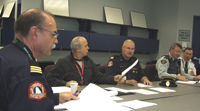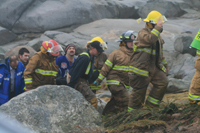
Features
Hot topics
Opinion
Being Prepared
Detailed departmental procedures key to helping others during disasters.
When your business is responding to other people’s emergencies, it can be all too easy to see yourself and your agency as somehow immune to the calamities that befall others in your community.
January 6, 2009
By Paul Dixon
 |
| Photo by Wayne Joy/Doug Hubley, Halifax Regional Fire and Emergency On Nov. 2, 2007, as Tropical Storm Noel approaches Nova Scotia, EMO co-ordinator Barry Manuel chairs a meeting of emergency managers in preparation for the storm. From left are Manuel, Divisional Chief Terry Bourgeois, Platoon Chief Bryson Wilson, Sgt. Jeff Wells and Insp. Darrell Beaton of the RCMP. |
Detailed departmental procedures key to helping others during disasters
When your business is responding to other people’s emergencies, it can be all too easy to see yourself and your agency as somehow immune to the calamities that befall others in your community. “Emergencies are our business” is often heard, as though just keeping a positive attitude will protect you and somehow enable your organization to overcome anything that comes its way. That attitude may have carried the day when fire engines were steam powered and pulled by horses, but the horses are long gone and that attitude is about as relevant today as a buggy whip holder.
Look back on events of the past 100 years that have defined the word “disaster” in this country by pushing emergency services to the brink – the Halifax Explosion, the SS Noronic fire in Toronto, the ice storm of 1997-’98, the blackout of 2003, wildfires in B.C. in 2003 and Hurricane Juan in the Maritimes, to name a few.
Your department has standard operating procedures or protocols for responding to major emergencies. They are an extension of your daily business. Are you able to operate under these guidelines when the event or a combination of events affects an entire region? Consider what firefighters in southern California were facing recently; wildfires driven by the Santa Ana winds raging out of control, ultimately threatening several of the primary hydro transmission lines supplying the Los Angeles region.
If nothing else happened, how would your department fare if you were required to run on emergency power for a day, a week or a month? A secondary threat that comes with just about every regional disaster is the loss of electrical power and the resultant loss of communications across the region. As we have adopted more sophisticated communications systems, we have conversely become more vulnerable to the loss of electricity.
In 2007, British Columbia’s Okanagan Valley was victim to an unforeseen wind storm that toppled trees over a 160 kilometre swath, knocking out power and communications throughout Penticton, Kelowna, Vernon and dozens of smaller communities. Chief Wayne Williams of Penticton Fire & Rescue relates that while there were emergency generators in place at fire halls and other key civic buildings, it quickly became apparent that the generators were not enough as the city’s newly installed Voice Over Internet Protocol phone system was rendered inoperable. The city has since expanded the emergency power network and ensured that adequate generators are on hand.
In July 2008, a fire in an underground electrical vault in Vancouver knocked out power to more than 4,000 commercial customers in the downtown core. Businesses across Canada were affected because servers for e-mail and financial transactions were affected, some for up to four days, leaving thousands of businesses across the country without e-mail and unable to process credit and debit card transactions. A relatively small event thousands of kilometres from your community can have a profound impact on your ability to conduct business.
 |
| Cellular phones should never be relied on as a replacement communications system for fire departments. Amateur radio has proven to be the one communications link that survives in a disaster. |
The general day-to-day operational cycle of fire departments is measured in minutes and hours but when disaster strikes that cycle can be stretched to days and even weeks. Systems, equipment and, most importantly, the people who operate them, have to be prepared to work to the new cycle.
Do you have adequate emergency power to meet the operational needs of a department operating in a post-disaster environment? Are your emergency generators equal to the load you will place on them when most needed? Do you test them regularly – not just starting them up from time to time, but make a point of running your operation on backup power for extended periods? How about fuel, for both the generators and your fleet – how long will it take you to exhaust your internal stores and how will you replenish them in time of crisis? Will it really be as simple as just calling your regular supplier for a delivery? How often do you replace your emergency fuel supply to ensure your generators will start and keep running?
What would cause your radio system to fail? Do you have alternate methods of communications and if so, how often do you test them? Cellular phones should never be relied on as a replacement communications system. If you have satellite phones, do you understand their limitations and have you trained your staff? Amateur radio has proven to be the one communications link that survives in a disaster, from Banda Aceh to Hurricane Katrina. How well connected is your department to amateur radio and have you ever run a real-time exercise using amateur radio?
The most important resource your department has is its people. Your facilities and equipment may survive a disaster but it takes those human resources to put them to work. Deputy Chief Dan Barnscher of Surrey Fire Service in B.C. realizes this. “The people who are working need to know what has happened to their families and loved ones while the people who are off duty need to be able to ensure the safety of their families before we can expect them to report for duty.”
For Surrey Fire Service that means providing staff with the information required to put a personal emergency plan in place for staff families. It also means developing an alternate communications plan in the realization that telephones and cell networks will not be operational. It means encouraging staff to develop informal support networks so that those living in the same neighbourhoods take responsibility for checking on each other’s well-being, depending on who is on shift and who is not. Just knowing that someone will be making the effort to contact and connect with families goes a long way to alleviate the stress of those who are working.
 |
| Photo by Wayne Joy/Doug Hubley, Halifax Regional Fire and Emergency Members from Station 55 in Seabright, N.S., move a man across the rocks at Peggy’s Cove the morning after Tropical Storm Noel struck. The man was picked up by a large wave and thrown about three metres onto the rocks. Planning for natural disasters is crucial for fire departments. |
On the job, it means a systematic approach to a post-disaster response. For Surrey Fire Service, in the wake of an earthquake, the first step is simply a size-up at each hall. Is the building still standing? Are there any injuries? Is the apparatus functional? If the building is still standing, how safe is it? To this end, Surrey is training a number of its members in rapid building assessment, to enable them to determine if a structure is safe enough to keep using it. Once the initial size-up is complete, the next step is to check in with fire communications. If there is no contact with the dispatch centre by radio or telephone, then attempt to connect with neighbouring fire stations to gather an overall idea of the situation. Then a “windshield survey” of the station’s response area by driving to key installations such as hospitals, care facilities and schools, conducting initial assessments and responding only to life safety issues.
In a post-disaster environment fire services must also integrate into a larger response model through a community or even regional Emergency Operations Centre (EOC). Deputy Chief Dave Burgess of North Vancouver City Fire Department realizes that it requires specialized skill sets for people to function effectively in a large EOC. “As I work through updating our current emergency plan, I realize that we have to ensure that our staff have the training and abilities to fulfill the roles assigned them within the emergency plan. Over the past few years we’ve had a significant turnover in personnel due to retirements and it’s a challenge to ensure that everyone gets the ICS and EOC training their position demands as they move up.”
Burgess also realizes that the emergency plan is a living document and not just limited to the fire department. “Our planning involves the City of North Vancouver engineering and other city departments for the areas where we overlap. We also get tremendous support from the staff at the North Shore Emergency Management Office in developing our plans.”
The District of North Vancouver is presently updating emergency plans for all departments within the municipality, including the District of North Vancouver Fire Rescue Service, under the direction of Fiona Dercole, the district’s manager of public safety. “We involve as many people as possible, working from response through recovery,” she says. “By engaging a large number of people in the process and using a ‘what if’ approach, we can see needs that we would not have thought of.”
 |
| The Surrey Fire Service in B.C. has a detailed protocol for the aftermath of an earthquake, including size-up at all stations to determine if the buildings are safe and if the apparatus are functional. |
Deputy Chief Vic Penman of DNVFRS sees the need to train as many people as possible in EOC operations and ICS. “Years ago the deputy chief was the one who had the knowledge and we had to wait for him to give direction. Today, we’re ensuring that all of our chief officers and company officers have that level of training.”
Fire departments do not operate in a vacuum. Effective post-disaster response, on a local or regional basis, requires the desire and ability to work with other agencies and organizations on as high a level as possible. It is unrealistic to expect that staff will stay on the job or report for duty and ignore their families or loved ones. Emergency plans should empower and enable staff and not restrict them. An emergency plan can only be effective if it is an extension of your organization’s daily operations.
Print this page